How does swine flu spread. Exploring Swine Flu: Key Facts About Human Infections with Variant Viruses
How does swine flu spread? What are the symptoms of variant virus infections in humans? Can people catch swine flu from eating pork? Get answers to these questions and more.
Understanding Swine Influenza
Swine influenza, or “swine flu,” is a respiratory disease that affects pigs, caused by type A influenza viruses. These viruses can cause high levels of illness in swine herds, though they usually result in few deaths. Common signs of illness in sick pigs include fever, depression, coughing, discharge from the nose or eyes, sneezing, breathing difficulties, eye redness or inflammation, and reduced appetite. However, infected pigs may also show no signs of illness or only mild symptoms. Swine influenza viruses tend to circulate among pigs throughout the year, with most outbreaks occurring during the late fall and winter months, similar to seasonal influenza in humans.
What Are Variant Influenza Viruses?
When an influenza virus that normally circulates in swine, but not in people, is detected in a human, it is called a “variant influenza virus.” For example, if a swine-origin influenza A H3N2 virus is found in a person, it would be called an “H3N2 variant” or “H3N2v” virus.
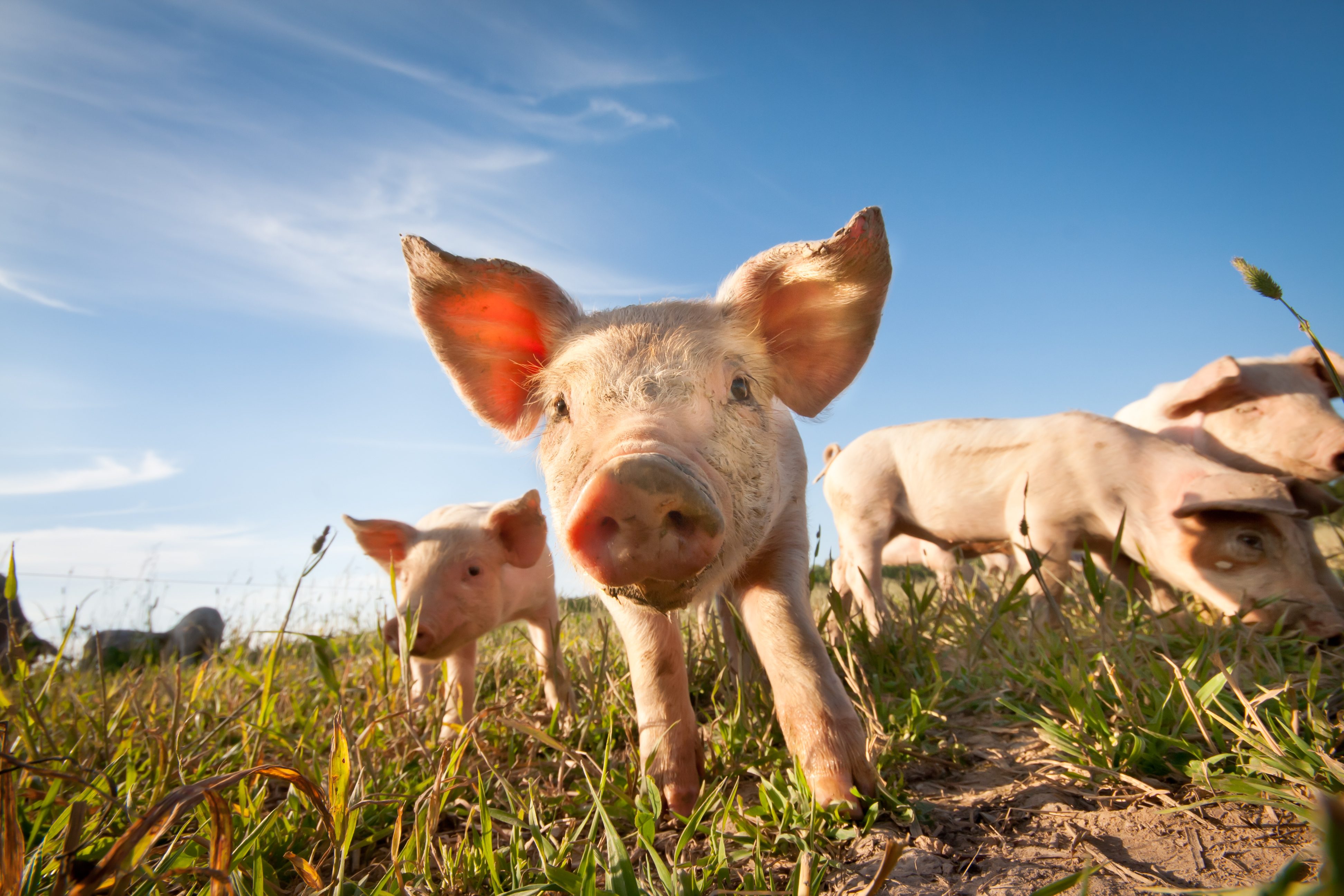
Can Humans Be Infected with Swine Influenza Viruses?
Yes, sporadic human infections with influenza viruses that normally infect swine have occurred. These types of infections are referred to as “variant virus” infections. Most commonly, human infections with variant viruses have been seen in people who have been exposed to infected pigs, such as children near pigs at a fair or workers in the swine industry. There have also been documented cases of multiple people becoming ill after exposure to one or more sick pigs, as well as limited instances of person-to-person spread of variant viruses.
How Common Are Human Infections with Swine Influenza Viruses?
In the past, the Centers for Disease Control and Prevention (CDC) received reports of approximately one human infected with influenza viruses that usually circulate in swine every one to two years. However, starting in 2012, there was a jump in the number of these cases. This increase could be due to a few factors, including improved surveillance and laboratory capacity to detect novel viruses, making variant influenza virus infections internationally and domestically reportable, and a potential true increase in the number of cases due to exposure to infected swine or limited human-to-human transmission.

Why Are Human Infections with Variant Viruses a Concern?
Influenza viruses that infect pigs may be different from human influenza viruses. As a result, influenza vaccines made against human influenza viruses are generally not expected to protect people from influenza viruses that normally circulate in pigs. Additionally, pigs are susceptible to avian, human, and swine influenza viruses, and if they are infected with influenza viruses from different species at the same time, the genes of these viruses can mix and create a new virus. This type of major change in the influenza A viruses is known as antigenic shift, and if the new virus can cause illness in people and be transmitted easily from person-to-person, it could lead to an influenza pandemic, as occurred in 2009 with the emergence of the H1N1 pandemic virus.
What Are the Symptoms of Variant Virus Infections in Humans?
People who have been infected with variant viruses have had symptoms similar to those of regular human seasonal influenza, including fever, lethargy, lack of appetite, coughing, sore throat, and runny nose. In some cases, severe illness and hospitalization have occurred, but the severity of illness can vary.

Can People Catch Swine Flu from Eating Pork?
No, people cannot catch swine flu/variant flu from eating pork. Swine influenza viruses are not transmitted through the consumption of pork or pork products. The viruses are primarily spread through direct contact with infected pigs or through exposure to respiratory droplets from infected pigs.
How Are Variant Influenza Viruses Spread?
Variant influenza viruses are primarily spread through direct contact with infected pigs or exposure to respiratory droplets from infected pigs. In some cases, limited person-to-person spread of variant viruses has occurred, but sustained transmission from human to human has not been reported.
How Can Variant Flu Infections in Humans Be Diagnosed?
Diagnostic testing is required to confirm a case of variant influenza virus infection in a human. This typically involves collecting a respiratory specimen from the infected individual and sending it to a public health laboratory for testing using specialized influenza diagnostic tests.

What Treatments Are Available for Variant Flu Infections?
The same antiviral medications used to treat regular seasonal influenza, such as oseltamivir (Tamiflu) and zanamivir (Relenza), may be used to treat variant influenza virus infections in humans. However, the effectiveness of these treatments can vary depending on the specific characteristics of the variant virus.
It is important to note that the information provided in this article is based on the current understanding of swine influenza and variant influenza viruses as of August 2023. As with any evolving public health issue, the situation and recommendations may change over time. Individuals should always consult with healthcare professionals and refer to reliable sources, such as the CDC, for the most up-to-date information and guidance.
Key Facts about Human Infections with Variant Viruses
- What symptoms do people have when they are infected with variant viruses?
- Can people catch swine flu/variant flu from eating pork?
- How are variant influenza viruses spread?
- How can human infections with variant influenza viruses be diagnosed?
- What medications are available to treat variant flu infections in humans?
Questions & Answers
This page contains background information about swine influenza virus infections in humans, now called “variant virus infections in humans.”
What is Swine Influenza?
Swine influenza (swine flu) is a respiratory disease of pigs caused by type A influenza viruses that regularly cause outbreaks of influenza in pigs. Swine flu viruses can cause high levels of illness in swine herds, but usually cause few deaths. Common signs in sick pigs include fever, depression, coughing (barking), discharge from the nose or eyes, sneezing, breathing difficulties, eye redness or inflammation, and going off feed. However, influenza-infected pigs also may not appear ill or be only mildly ill. Swine influenza viruses may circulate among swine throughout the year, but most outbreaks occur during the late fall and winter months similar to outbreaks of seasonal influenza in humans.
However, influenza-infected pigs also may not appear ill or be only mildly ill. Swine influenza viruses may circulate among swine throughout the year, but most outbreaks occur during the late fall and winter months similar to outbreaks of seasonal influenza in humans.
What is a variant influenza virus?
When an influenza virus that normally circulates in swine (but not people) is detected in a person, it is called a “variant influenza virus.” For example, if a swine origin influenza A h4N2 virus is detected in a person, that virus will be called an “h4N2 variant” virus or “h4N2v” virus. This naming convention was first announced in a January 6, 2012 Morbidity and Mortality Weekly Report entitled Update: Influenza A (h4N2)v Transmission and Guidelines — Five States, 2011. (Reference)
Graphic: Flu Can Spread Between Pigs and People pdf icon[1.2 MB, 2 pages]
Spanish pdf icon[1.2 MB, 2 pages]
Can humans be infected with swine influenza viruses?
Yes.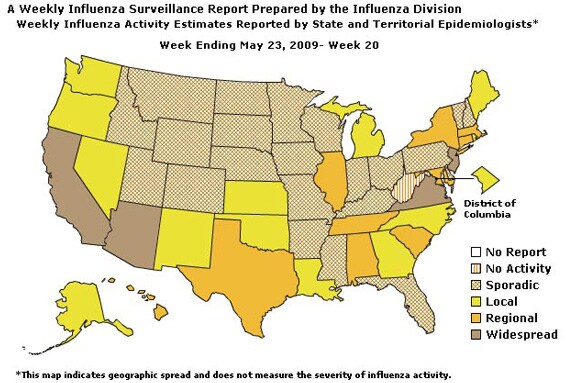 Swine flu viruses do not normally infect humans, however, sporadic human infections with influenza viruses that normally infect swine have occurred. When this happens, these viruses are called “variant viruses.” Most commonly, human infections with variant viruses have occurred in people exposed to infected pigs (e.g., children near pigs at a fair or workers in the swine industry). In addition, there have been documented cases of multiple persons becoming sick after exposure to one or more sick pigs. Also, cases of limited person-to-person spread of variant viruses have occurred.
Swine flu viruses do not normally infect humans, however, sporadic human infections with influenza viruses that normally infect swine have occurred. When this happens, these viruses are called “variant viruses.” Most commonly, human infections with variant viruses have occurred in people exposed to infected pigs (e.g., children near pigs at a fair or workers in the swine industry). In addition, there have been documented cases of multiple persons becoming sick after exposure to one or more sick pigs. Also, cases of limited person-to-person spread of variant viruses have occurred.
How common is it for humans to be infected with influenza viruses that normally infect swine?
In the past, CDC received reports of approximately one human infected with influenza viruses that usually are found in swine every one to two years, but beginning in 2012, there was a jump in the number of these cases. (See Case Count: Detected U.S. Human Infections with Variant Influenza Viruses by State since December 2005. ) The increased detection and reporting of these cases could be occurring for a number of reasons, including one or more of the following factors: first, pandemic preparedness efforts have improved state level surveillance and laboratory capacity to detect novel viruses in the United States; second, in 2005, novel influenza virus infections were made internationally reportable; and in 2007 they were made domestically reportable. And third, it’s also possible that there is a true increase in the number of these cases, possibly occurring from exposure to infected swine or through subsequent, limited human-to-human transmission.
) The increased detection and reporting of these cases could be occurring for a number of reasons, including one or more of the following factors: first, pandemic preparedness efforts have improved state level surveillance and laboratory capacity to detect novel viruses in the United States; second, in 2005, novel influenza virus infections were made internationally reportable; and in 2007 they were made domestically reportable. And third, it’s also possible that there is a true increase in the number of these cases, possibly occurring from exposure to infected swine or through subsequent, limited human-to-human transmission.
Why are human infections with variant viruses of concern?
Influenza viruses that infect pigs may be different from human influenza viruses. Thus, influenza vaccines made against human influenza viruses are generally not expected to protect people from influenza viruses that normally circulate in pigs. In addition, because pigs are susceptible to avian, human and swine influenza viruses, they potentially may be infected with influenza viruses from different species (e.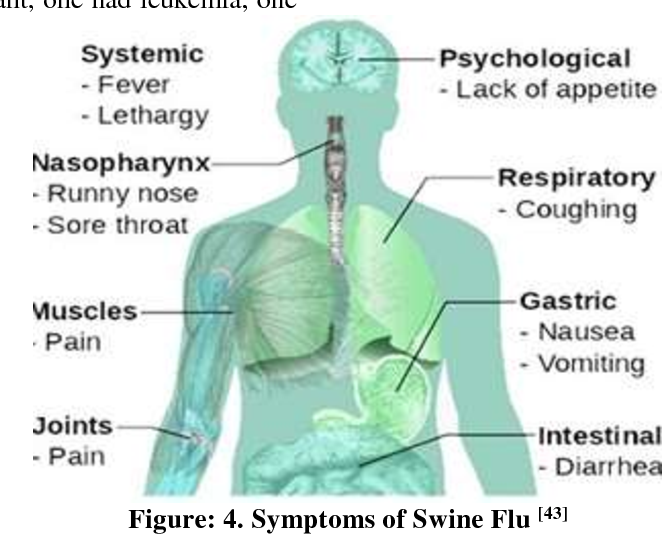 g., ducks and humans) at the same time. If this happens, it is possible for the genes of these viruses to mix and create a new virus. This type of major change in the influenza A viruses is known as antigenic shift. If this new virus causes illness in people and can be transmitted easily from person-to-person, an influenza pandemic can occur. This is what happened in 2009 when an influenza A h2N1 virus with swine, avian and human genes emerged in the spring of 2009 and caused the first pandemic in more than 40 years.
g., ducks and humans) at the same time. If this happens, it is possible for the genes of these viruses to mix and create a new virus. This type of major change in the influenza A viruses is known as antigenic shift. If this new virus causes illness in people and can be transmitted easily from person-to-person, an influenza pandemic can occur. This is what happened in 2009 when an influenza A h2N1 virus with swine, avian and human genes emerged in the spring of 2009 and caused the first pandemic in more than 40 years.
What symptoms do people have when they are infected with variant viruses?
People who have been infected with variant viruses have had symptoms similar to the symptoms of regular human seasonal influenza. These include fever, lethargy, lack of appetite and coughing. Some people also have reported runny nose, sore throat, eye irritation, nausea, vomiting and diarrhea.
Can people catch swine flu/variant flu from eating pork?
Swine influenza has not been shown to be transmissible to people through eating properly handled and prepared pork (pig meat) or other products derived from pigs. For more information about the proper handling and preparation of pork, visit the USDA website fact sheet Fresh Pork from Farm to Tableexternal icon.
For more information about the proper handling and preparation of pork, visit the USDA website fact sheet Fresh Pork from Farm to Tableexternal icon.
How are variant influenza viruses spread?
Influenza viruses can be directly transmitted from pigs to people and from people to pigs. These infections have most commonly been reported after close proximity to infected pigs, such as in pig barns and livestock exhibits housing pigs at fairs. Infected pig cough or sneeze and droplets with influenza virus in them can spread through the air. If these droplets land in your nose or mouth, or are inhaled, you can be infected. There also is some evidence that you might get infected by touching a surface with virus on it and then touching your mouth or nose. A third way to possibly get infected is to inhale droplets or dust containing influenza virus. Scientists aren’t really sure which of these ways of spread is the most common.
Human-to-human transmission of variant flu viruses also has occurred, though this method of spread has been limited. This kind of transmission is thought to occur in the same way that seasonal flu transmits in people, which is mainly through coughing or sneezing by people who are infected. People also may become infected by touching something with flu viruses on it and then touching their mouth or nose. It’s important to note that in most cases, variant flu viruses have not shown the ability to spread easily and sustainably from person to person.
This kind of transmission is thought to occur in the same way that seasonal flu transmits in people, which is mainly through coughing or sneezing by people who are infected. People also may become infected by touching something with flu viruses on it and then touching their mouth or nose. It’s important to note that in most cases, variant flu viruses have not shown the ability to spread easily and sustainably from person to person.
How can human infections with variant influenza viruses be diagnosed?
To diagnose variant influenza A virus infection, a respiratory specimen would generally need to be collected within the first 4 to 5 days of illness (when an infected person is most likely to be shedding virus). However, some people, especially children, may shed virus longer. Since the 2009 h2N1 pandemic, state health departments have the ability to test for novel (non-human) influenza viruses. However, if a variant influenza virus is suspected, it is sent to CDC for further testing.
What medications are available to treat variant flu infections in humans?
There are four different antiviral drugs that are recommended for use in the United States for the treatment of influenza: oseltamivir, peramivir, zanamivir, and baloxavir.
For information about seasonal influenza, visit the CDC Seasonal Influenza (Flu) website.
For more information on human infections, visit Past Reports of Human Infections with Variant Viruses.
Resources
- Graphic: Flu Can Spread Between Pigs and People pdf icon[1.2 MB, 2 pages] | Spanish pdf icon[1.2 MB, 2 pages]
- Key Facts for People Exhibiting Pigs at Fairs pdf icon[545 KB, 2 pages]
- Take Action to Prevent the Spread of Flu Between People and Pigs pdf icon[1.3 MB, 2 pages]
- Educational Poster pdf icon[389 KB, 1 page]external icon
- Compendium of Measures to Prevent Disease Associated with Animals in Public Settings, 2013external icon
- Reduce Your Risk (English) pdf icon[22 KB, 1 page]external icon | (Spanish) pdf icon[22 KB, 1 page]external icon
- Measures to Minimize Influenza Transmission at Swine Exhibitions, 2018 – NASAHO and NASPHV pdf icon[97 KB, 8 pages]external icon
- Past Reports of Human Infections with Variant Viruses
- Medscape Commentary: CDC Guidance for Swine Influenza Virus Infectionexternal icon
- Infectious Disease News: ‘Common-Sense’ precautions reduce risk for variant flu at fairsexternal icon
- CSTE: Flu Education Among Youth in Agriculture Resource Repositoryexternal icon
h2N1 Influenza – StatPearls – NCBI Bookshelf
Continuing Education Activity
h2N1 influenza is a subtype of influenza A virus, a communicable viral illness which causes upper and in some cases lower respiratory tract infections in its host.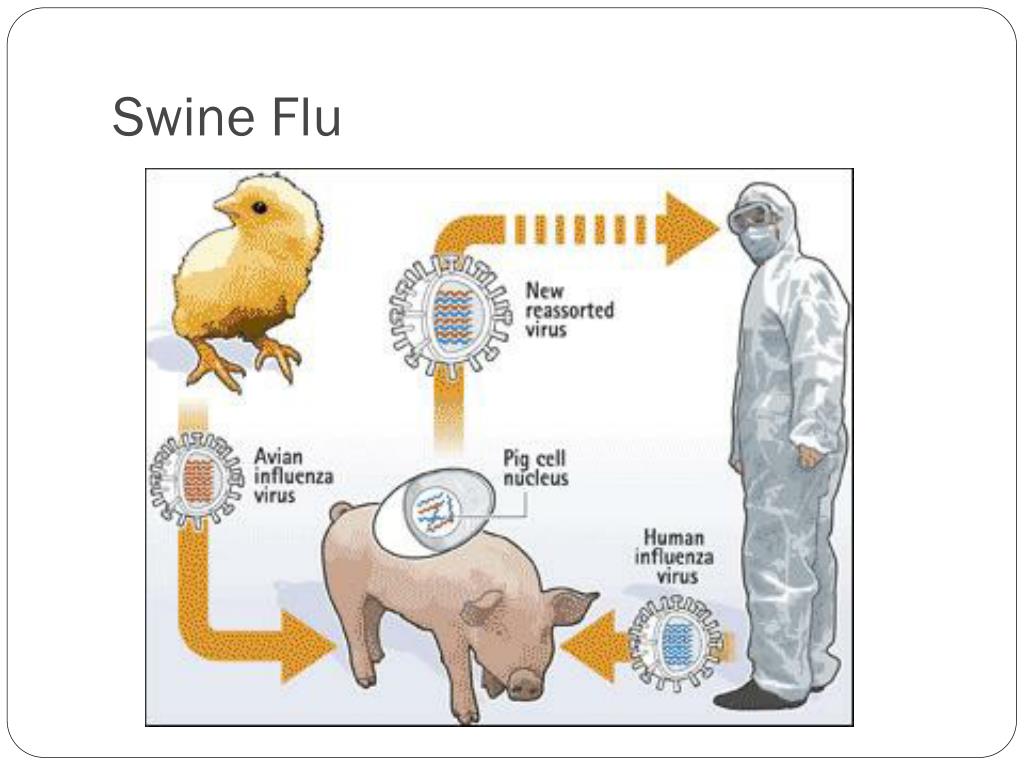 This results in symptoms such as nasal secretions, chills, fever, decreased appetite, and in some cases, lower respiratory tract disease. This activity reviews the presentation, evaluation, and management of h2N1 influenza and stresses the role of an interprofessional team approach to the care of affected patients.
This results in symptoms such as nasal secretions, chills, fever, decreased appetite, and in some cases, lower respiratory tract disease. This activity reviews the presentation, evaluation, and management of h2N1 influenza and stresses the role of an interprofessional team approach to the care of affected patients.
Objectives:
Identify the global, historical impact of h2N1 influenza.
Summarize the transmission of h2N1 influenza.
Describe the common symptoms associated with h2N1 influenza.
Explain the importance of improving care coordination, with particular emphasis on communication between interprofessional medical teams, to enhance prompt and thorough delivery of care to patients with h2N1 influenza and prevent further disease spread.
Access free multiple choice questions on this topic.
Introduction
h2N1 Swine flu is a subtype of influenza A virus (a communicable viral disease), which causes upper, and potentially, lower respiratory tract infections in the host it infects, resulting in symptoms such as nasal secretions, chills, fever, decreased appetite, and possibly lower respiratory tract disease. h2N1 swine influenza is a common infection in pigs worldwide, and that is why it is also known as swine flu. h2N1 swine flu leads to respiratory disease that can potentially infect the respiratory tract of pigs. Sometimes, people who are closely associated with pigs or in the proximity of pigs have developed swine flu (zoonotic swine flu). Swine influenza viruses can potentially cause infections in humans if antigenic characteristics of the virus change through reassortment. When this happens, transmission from person-to-person is usually inefficient. Influenza A pandemics such as the ones in 1918 and 2009 can occur if the transmission from person-to-person becomes efficient. [1]
h2N1 swine influenza is a common infection in pigs worldwide, and that is why it is also known as swine flu. h2N1 swine flu leads to respiratory disease that can potentially infect the respiratory tract of pigs. Sometimes, people who are closely associated with pigs or in the proximity of pigs have developed swine flu (zoonotic swine flu). Swine influenza viruses can potentially cause infections in humans if antigenic characteristics of the virus change through reassortment. When this happens, transmission from person-to-person is usually inefficient. Influenza A pandemics such as the ones in 1918 and 2009 can occur if the transmission from person-to-person becomes efficient. [1]
In 1918, a deadly influenza pandemic caused by h2N1 influenza virus, also known as the Spanish flu, infected approximately 500 million people around the world and resulted in the deaths of 50 to 100 million people (3% to 5% of the world population) worldwide, distinguishing it as one of the most deadly pandemics in human history. In 2009, a new strain h2N1 swine flu spread fast around the world among humans, and the World Health Organization (WHO) labeled it a pandemic. However, the 2009 h2N1 virus was not zoonotic swine flu because it was not transferred from pigs to humans. Instead, it spread through airborne droplets from human to human, and potentially, through human contact with inanimate objects contaminated with the virus and transferred to the eyes or nose. This virus caused similar symptoms to those seen in swine, possibly due to reassortment of the viral RNA structure, which allowed human-to-human transfer. [2][3]
In 2009, a new strain h2N1 swine flu spread fast around the world among humans, and the World Health Organization (WHO) labeled it a pandemic. However, the 2009 h2N1 virus was not zoonotic swine flu because it was not transferred from pigs to humans. Instead, it spread through airborne droplets from human to human, and potentially, through human contact with inanimate objects contaminated with the virus and transferred to the eyes or nose. This virus caused similar symptoms to those seen in swine, possibly due to reassortment of the viral RNA structure, which allowed human-to-human transfer. [2][3]
Despite the name, an individual cannot acquire swine flu from eating pig products such as bacon, ham, and other pig products.
Etiology
The h2N1 influenza virus is an orthomyxovirus and produces virions that are 80 to 120 nm in diameter, with an RNA genome size of approximately 13.5 kb. The swine influenza genome has 8 different regions which are segmented and encode 11 different proteins:
Envelope proteins hemagglutinin (HA) and neuraminidase (NA)
Viral RNA polymerases which include PB2, PB1, PB1-F2, PA, and PB
Matrix proteins M1 and M2
Nonstructural proteins NS1 and NS2 (NEP), which are crucial for efficient pathogenesis and viral replication
The surface glycoproteins HA and NA are how the h2N1-strain is differentiated from other strains of influenza A (h2N1, h2N2) depending on the type of HA or NA antigens expressed with metabolic synergy.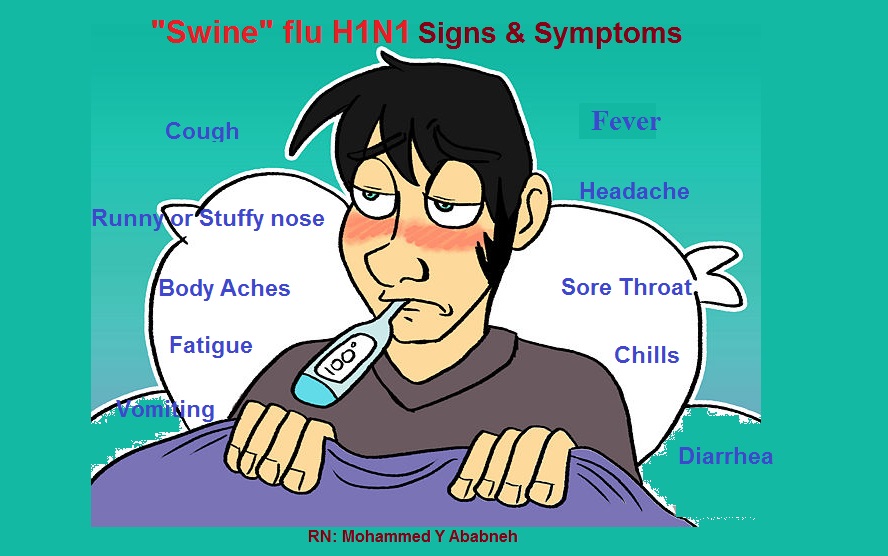 The function of hemagglutinin is to cause red blood cells to cluster together, and it attaches the virus to the infected cell. Neuraminidase helps move the virus particles through the infected cell and assists in budding from host cells.
The function of hemagglutinin is to cause red blood cells to cluster together, and it attaches the virus to the infected cell. Neuraminidase helps move the virus particles through the infected cell and assists in budding from host cells.
The h2N1 swine influenza viruses can potentially cause infections in humans if antigenic characteristics of the virus change. In 2009, the pandemic which started in Mexico with the h2N1 strain displayed a combination of segments of 4 different influenza viruses (quadruple genetic reassortment): pig-origin flu North American avian (comprising 34.4%), bird-origin flu of the human influenza strain (comprising 17.5%), North American swine (comprising 30.6%), and Eurasian swine (comprising 17.5%). Due to this coinfection with influenza virus from diverse animal species, the viruses were able to interact, mutate, and form new strains that had variable immunity. Although it had originated in pigs, it was able to spread from human to human. When the flu spreads from human-to-human, instead of from animals to humans, there can be further mutations, making it harder to treat because people have no natural immunity. [4][5][6]
[4][5][6]
Epidemiology
Swine flu was first isolated from pigs in the 1930s by researchers in the United States and was subsequently recognized by pork producers and veterinarians as a cause of flu infections in pigs worldwide, and for the next 60 years, h2N1 was the predominant swine influenza strain. People who are closely associated with pigs have been known to develop an infection, and pigs have also been infected with human flu from these handlers. In the vast majority of cases, cross-species transmission of the virus had remained confined to the specific area and not caused national or global infections in either pigs or humans. Unfortunately, due to the potential for genetic variation in the swine flu virus, there is always a possibility for cross-species transmission with the influenza viruses to occur. Investigators concluded that the “2009 swine flu” strain, which originated in Mexico, was termed novel h2N1 flu since it was mainly found infecting humans and exhibits 2 main surface antigens, hemagglutinin type 1 and neuraminidase type 1.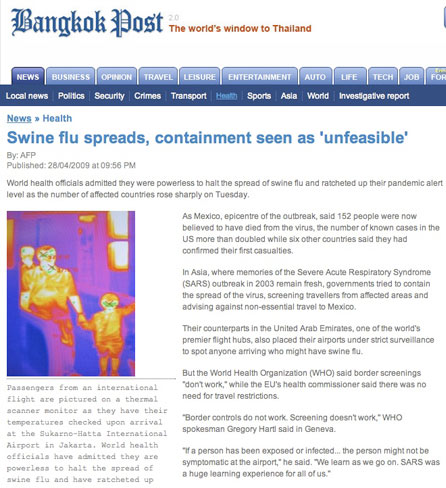 The 8 RNA strands in novel h2N1 flu have 1 strand from human flu strains, 2 derived from avian (bird) strains, and 5 that were derived from swine strains. During the 2009 pandemic, the Centers for Disease and Control and Prevention (CDC) estimated that there were 43 to 89 million cases of swine flu reported during a 1-year span, with 1799 deaths in 178 countries worldwide. [7][8]
The 8 RNA strands in novel h2N1 flu have 1 strand from human flu strains, 2 derived from avian (bird) strains, and 5 that were derived from swine strains. During the 2009 pandemic, the Centers for Disease and Control and Prevention (CDC) estimated that there were 43 to 89 million cases of swine flu reported during a 1-year span, with 1799 deaths in 178 countries worldwide. [7][8]
The 1918 deadly influenza pandemic caused by h2N1 influenza virus, infected approximately 500 million people around the world and caused the death of roughly fifty to a hundred million people. The h2N1 variant of swine flu is the progeny of the strain that caused the 1918 swine flu pandemic. Although persisting in pigs, the descendant variants of the 1918 virus have also known to infect humans, contributing to the yearly seasonal epidemics of influenza. Direct transmission of the virus from pigs to humans is a rare occurrence, with only 12 documented cases in the United States since 2005. The potential retention of influenza virus strains in swine after these strains have disappeared in the human population, essentially make pigs a reservoir where swine influenza viruses could persist, and later emerge to reinfect humans once their immunity to these strains has waned. [1][9]
[1][9]
More recently in 2015, a mutant strain of h2N1 which caused the global pandemic in 2009, spread across India with over 10,000 reported cases and 774 deaths.
People who have a higher risk of becoming seriously ill if infected include:
Children younger than 5 years old
Adults older than age 65, younger adults, and children under age 19 who are on long-term aspirin therapy
People with compromised immune systems due to diseases such as AIDS
Currently gestating females
People suffering from chronic diseases such as asthma, heart disease, diabetes mellitus, or neuromuscular disease
Pathophysiology
h2N1 swine flu is an acute disease that infects the upper respiratory tract and can cause inflammation of the upper respiratory passages, trachea, and possibly the lower respiratory tract. The known incubation period for h2N1 swine flu ranges from 1 to 4 days, with the average around 2 days in most individuals, but some individuals, it may be as long as 7 days. The contagious period for adults starts about 1 day before symptoms develop and lasts around 5 to 7 days after the person develops symptoms. The contagious period may be longer in individuals with weakened immune systems and children (e.g., 10 to 14 days).
The contagious period for adults starts about 1 day before symptoms develop and lasts around 5 to 7 days after the person develops symptoms. The contagious period may be longer in individuals with weakened immune systems and children (e.g., 10 to 14 days).
The acute symptoms of uncomplicated infections persist for three to seven days, and the disease is mostly self-limited in healthy individuals, but malaise and cough can persist for up to 2 weeks in some patients. Patients with more severe disease may require hospitalization, and this may increase the time of infection to around 9 to 10 days. The body’s immune reaction to the virus and the interferon response are the causes of the viral syndrome which includes high fever, coryza, and myalgia. Patients with chronic lung diseases, cardiac disease and who are currently pregnant are at higher risk of severe complications such as viral pneumonia, superimposed bacterial pneumonia, hemorrhagic bronchitis, and possibly death. These complications can potentially develop within 48 hours from the onset of symptoms. The replication of the virus occurs primarily in the upper and lower respiratory tract passages from the time of inoculation and peaks around 48 hours in most patients. The recommended time of isolation of the infected patient is around 5 days. [10]
The replication of the virus occurs primarily in the upper and lower respiratory tract passages from the time of inoculation and peaks around 48 hours in most patients. The recommended time of isolation of the infected patient is around 5 days. [10]
Histopathology
Swine flu causes most symptoms in upper and lower respiratory tracts. Mild cases usually show a few pathologic changes in the respiratory tract, but severe cases can show clear pathologic changes of pneumonia. The pathological findings associated with swine flu include multifocal destruction and potential desquamation of the pseudo columnar and columnar epithelial cells, and possibly prominent hyperemia and edema in the submucosa. There may also be thrombus formation at the bronchiolar level. Sometimes, the acute inflammation could be severe and indicated by hemorrhagic tracheobronchitis and desquamative bronchiolitis, which could cause necrosis of the bronchiolar wall. Once necrosis occurs, polymorphs and mononuclear cells infiltrate into the affected area.
Histological changes in swine influenza pneumonia include: interstitial edema with possible inflammatory infiltrate, alveolar proteinaceous exudation associated with membrane formation, thrombosis of capillaries, necrosis of the alveolar septae, intra-alveolar hemorrhage, dislocation of desquamated pneumocytes with pyknotic nuclei into the surrounding alveolar spaces, diffuse alveolar damage with infiltration by the lymphocytes and histiocytes into the interstitium. During the late stage, the following changes have been reported in patients: diffuse alveolar damage, fibrosis, hyperplasia of the type II pneumocyte, epithelial regeneration, and squamous metaplasia have been found. These changes are characteristic of the fibroproliferative stage of acute respiratory distress syndrome and diffuse alveolar destruction. Bacterial coinfections were also identified in some autopsy cases. The most common bacteria isolated included Streptococcus pneumoniae, Streptococcus pyogenes, Staphylococcus aureus, community-acquired, methicillin-resistant Staphylococcus aureus, and Haemophilus influenzae.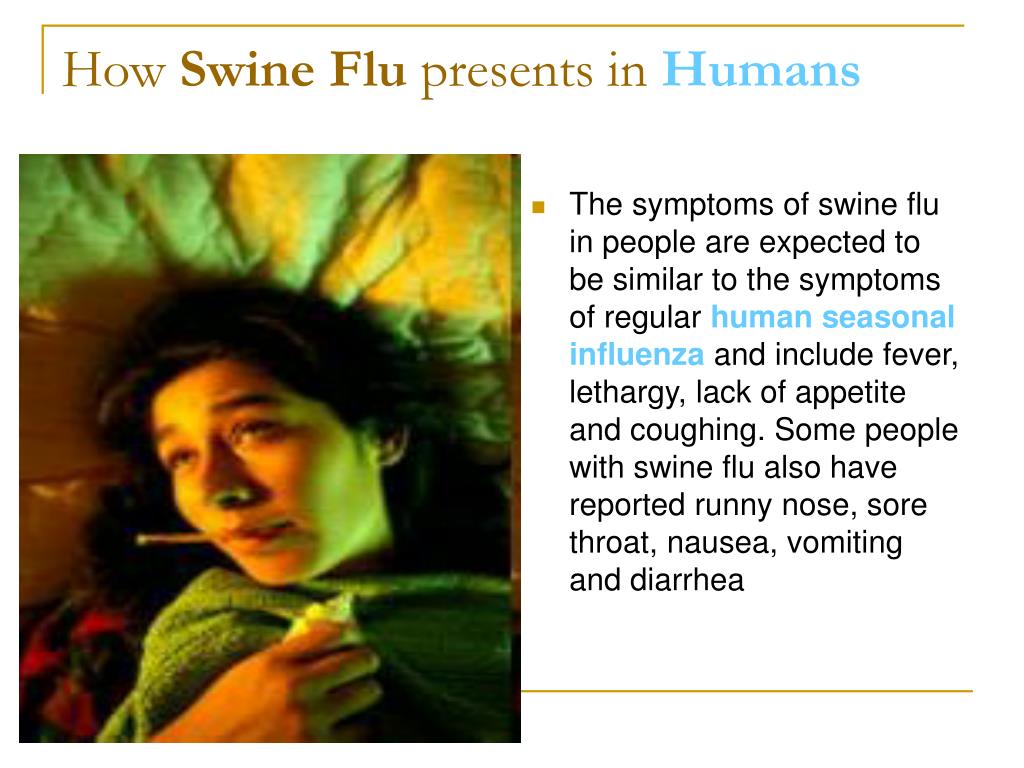
History and Physical
The history and clinical presentations of h2N1 swine influenza have ranged from mild flu symptoms to severe respiratory symptoms (and possibly death) depending on the age of the patient, co-morbidities, vaccination status, and natural immunity in patients to the virus. According to the CDC, the signs and symptoms in humans infected with the 2009 h2N1 swine flu were similar to those of influenza. These include a fever and chills, cough, sore throat, congested eyes, myalgia, shortness of breath, weight loss, chills, sneezing, headache, rhinorrhea, coughing, dizziness, abdominal pain, decreased appetite, and fatigue. The 2009 h2N1 strain also showed an increased number of people reporting vomiting and diarrhea as well. Because most of these symptoms are not exclusive to swine flu, a detailed history must also be taken to take into account the differential diagnosis of swine flu if the patient has directly contacted someone with confirmed swine flu or has been in an area that had documented cases of swine flu. Respiratory failure was the most common cause of death in severe cases. Other causes included high fever (causing neurological problems), pneumonia (causing sepsis), dehydration and severe hypotension (from vomiting and diarrhea), electrolyte imbalance associated complications, and kidney failure. More severe cases and fatalities were more likely observed in children younger than 5 years of age and elderly patients older than 60 years.
Respiratory failure was the most common cause of death in severe cases. Other causes included high fever (causing neurological problems), pneumonia (causing sepsis), dehydration and severe hypotension (from vomiting and diarrhea), electrolyte imbalance associated complications, and kidney failure. More severe cases and fatalities were more likely observed in children younger than 5 years of age and elderly patients older than 60 years.
Other risk factors for severe disease include lung disorders such as chronic obstructive pulmonary disease (COPD), bronchial asthma, pneumonia, currently pregnant women, obesity, patients undergoing immunosuppressive therapy due to cancer or autoimmune disease, and underlying medical issues such as diabetes. Pregnant women acquired the infection during their third trimester were at greater risk for complications.
Evaluation
Influenza A (h2N1) virus infection could be encountered in a wide range of clinical settings and may result in variable pathologic findings.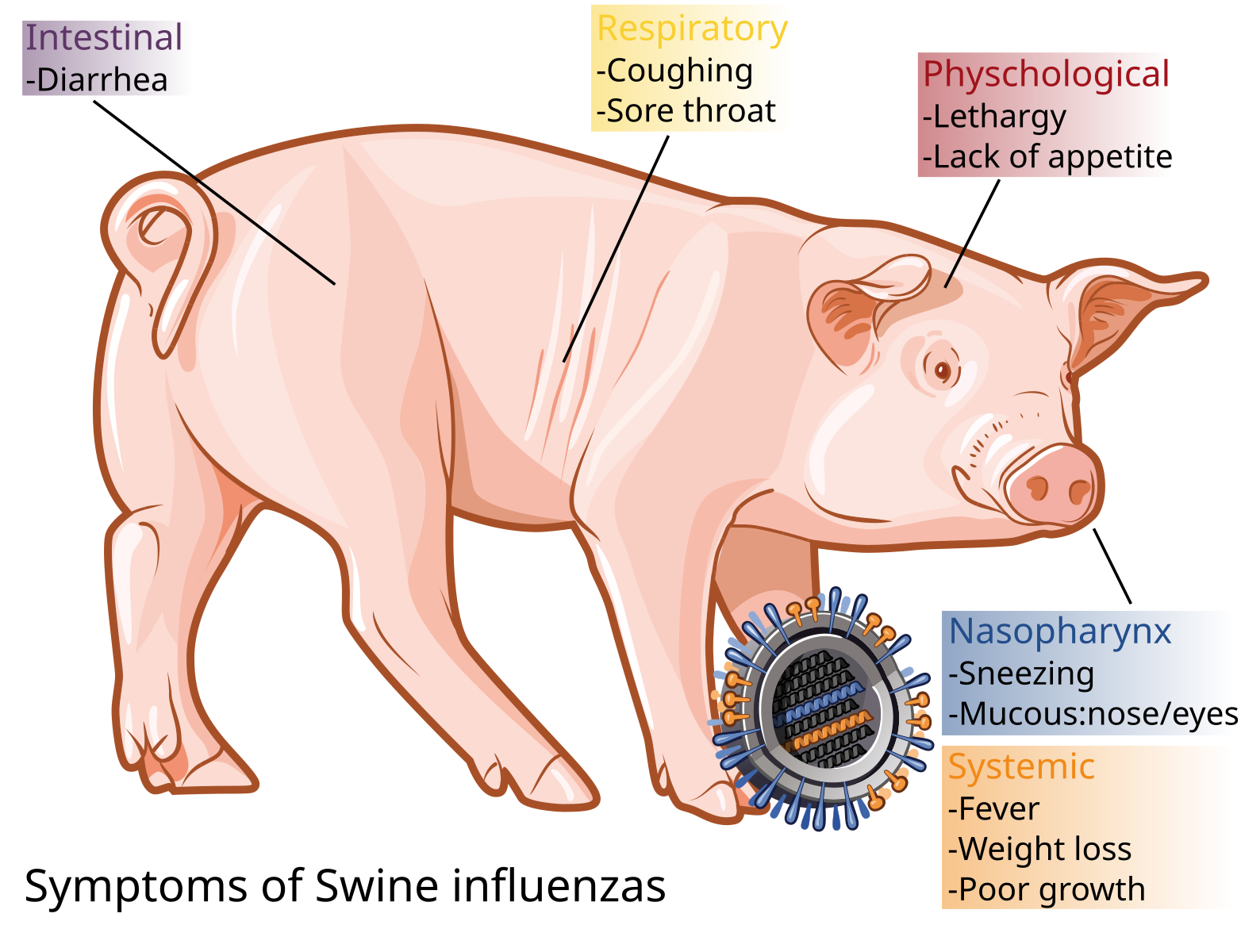 h2N1 should be one of the differential diagnosis in patients who present with unexplained flu-like symptoms or acute pneumonia in an area with known swine flu cases. Routine investigations should be performed for the patient who presents with these symptoms. These usually include hematological, microbiological, biochemical and radiologic tests. A respiratory sample (simple nose or throat swab) is required for a confirmed diagnosis of swine flu. In humans, these tests include the Reverse transcriptase-polymerase chain reaction test (RT-PCR), virus isolation test, and assays to detect a 4-fold increase in influenza virus antigens. The routine tests done to detect human influenza viruses, including the rapid test kits, do not always detect zoonotic viruses.
h2N1 should be one of the differential diagnosis in patients who present with unexplained flu-like symptoms or acute pneumonia in an area with known swine flu cases. Routine investigations should be performed for the patient who presents with these symptoms. These usually include hematological, microbiological, biochemical and radiologic tests. A respiratory sample (simple nose or throat swab) is required for a confirmed diagnosis of swine flu. In humans, these tests include the Reverse transcriptase-polymerase chain reaction test (RT-PCR), virus isolation test, and assays to detect a 4-fold increase in influenza virus antigens. The routine tests done to detect human influenza viruses, including the rapid test kits, do not always detect zoonotic viruses.
An indication that a novel, possibly zoonotic swine influenza virus could be present, is a detection of the influenza A virus, but not of the hemagglutinins in the seasonal human influenza viruses. The zoonotic influenza virus infections can sometimes be diagnosed retrospectively by serology, but potential cross-reactivity with human influenza viruses can complicate this diagnosis. Another concern is that the neuraminidase (NA) and hemagglutinin (HA) of some swine influenza viruses (the main target of the antibodies) originated from human influenza viruses, to which people could have already been exposed.
Another concern is that the neuraminidase (NA) and hemagglutinin (HA) of some swine influenza viruses (the main target of the antibodies) originated from human influenza viruses, to which people could have already been exposed.
State, regional, and national public health laboratories do generally test for the novel influenza viruses.
Treatment / Management
The initial and best step in management should be to prevent swine flu. Specifically, with the prevention of swine flu in swine, prevention of transmission of swine flu from swine-to-humans, and prevention of human-to-human spread.
Prevention of swine flu in swine: Main methods to prevent swine flu in pigs involve facility management (using disinfectants and regulated temperature to control viruses in the environment), herd management (not adding pigs possibly carrying influenza to the herds that have not yet been exposed to the virus), and vaccination. As much of the morbidity and mortality observed with swine flu is due to secondary infection by other pathogens, strategies that solely rely on vaccination may be insufficient.

Prevention of swine to human viral transmission: Because swine can be infected with avian and human strains of h2N1 influenza, they are the primary hosts where antigenic shifts occur that can cause new strains of swine flu. Transmission of the influenza virus from swine to humans is usually seen in people who have a close association with pigs, such as farmers, pork handlers, and veterinarians. These individuals are strongly encouraged to wear face-masks when dealing with the animals to prevent transmission through respiratory droplets. The most important step of prevention is vaccination of the swine. Individuals with increased risk of acquiring swine flu through pigs are those who smoke and do not wear gloves or masks when dealing with infected animals, increasing the risk of possible hand-to-nose, hand-to-eye, or hand-to-mouth transmission.
Prevention of human to human transmission: The main route of swine flu virus spread between humans is exposure to the virus when someone infected sneezes or coughs, and the virus enters one of the potential mucous surfaces, or when a person touched something infected with the virus and subsequently touch their nose, mouth, and surrounding areas.
 Swine flu is most contagious in the first 5 days of illness in most people, although this may increase in children and the elderly. Current CDC recommendations to prevent the spread of the virus include frequent handwashing with soap and water or alcohol-based sanitizers, and also disinfecting household, hospital and public settings by cleaning with a diluted bleach solution. Anyone who resides in an area where the disease is prevalent and suspects an infection or presents with flu-like symptoms, should stay away from work and public transportation and immediately see a doctor.
Swine flu is most contagious in the first 5 days of illness in most people, although this may increase in children and the elderly. Current CDC recommendations to prevent the spread of the virus include frequent handwashing with soap and water or alcohol-based sanitizers, and also disinfecting household, hospital and public settings by cleaning with a diluted bleach solution. Anyone who resides in an area where the disease is prevalent and suspects an infection or presents with flu-like symptoms, should stay away from work and public transportation and immediately see a doctor.
The best-known prevention method against swine flu is getting the h2N1 swine flu vaccine. In September 2009, the FDA permitted the new swine flu vaccine, and various studies by the National Institute of Health (NIH) showed that a single dose was enough to create sufficient antibodies to protect against the virus within 10 days. The vaccination is contraindicated in people who had a previous severe allergic reaction to the influenza vaccination. Those who are moderate to severely ill, including those with or without a fever, should take the vaccination when they recover or are asymptomatic.
Those who are moderate to severely ill, including those with or without a fever, should take the vaccination when they recover or are asymptomatic.
The management for infected patients depends on the severity of symptoms of influenza, mild to moderate influenza can be treated at home with rest, oral hydration and symptomatic treatment with antipyretics like paracetamol, antihistaminic for nasal congestion and rhinitis and NSAIDS or Paracetamol for headaches and body aches. Patients with progressive or severe symptoms should be admitted to hospitals and preferably in intensive care units (ICU) if there are signs suggestive of impending respiratory failure or sepsis or multiorgan dysfunction. Aggressive supportive measures like intravenous (IV) hydration, correction of electrolyte imbalances, antibiotics for concomitant bacterial infections. Patients developing acute respiratory distress syndrome (ARDS) secondary to influenza should be treated with noninvasive or invasive mechanical ventilation. Severe cases of h2N1-induced ARDS have required the use of extracorporeal membrane oxygenation (ECMO).
Severe cases of h2N1-induced ARDS have required the use of extracorporeal membrane oxygenation (ECMO).
The antiviral medications: zanamivir, oseltamivir, and peramivir have been documented to help reduce, or possibly prevent, the effects of swine flu if the medication is taken within 48 hours of the onset of symptoms. Known side effects of oseltamivir comprise skin conditions that are occasionally severe and sporadic transient neuropsychiatric events. These possible side effects are the reason the use of oseltamivir is cautioned in the elderly and individuals that have a higher risk of developing these side effects. An allergy to eggs is the only contraindication to zanamivir. Beginning October 1, 2008, the CDC tested 1146 seasonal influenza A (h2N1) collected viruses for resistance to the drugs oseltamivir and zanamivir. It concluded that 99.6% of the samples showed resistance to oseltamivir while none showed resistance to zanamivir. Of the 853 collected samples of the 2009 influenza A (h2N1) virus, only 4% demonstrated resistance to oseltamivir, while none of the 376 samples collected showed resistance to zanamivir.
Pregnant women who contract the h2N1, are at a greater risk of complications because of the body’s hormonal changes, physical changes and changes to their immune system to accommodate the growing fetus. For these reasons, the CDC recommends that all pregnant women get vaccinated to prevent the swine influenza virus. Swine influenza in pregnant women can be treated using antiviral medications: oseltamivir and zanamivir (neuraminidase inhibitors). It has been demonstrated that these 2 drugs are most effective when taken within 2 days of becoming sick. [11][12][13]
Differential Diagnosis
Adenovirus
Arenaviruses
Cytomegalovirus
Dengue
Echovirus infection
Prognosis
Evaluation of data reveals that some patients admitted with swine flu are at risk for sepsis, ARDS and death. Predictors of death include chronic lung disease, obesity, underlying neurological diseases, delayed admission, and other co-morbidity.
Enhancing Healthcare Team Outcomes
Swine flu is very contagious and is easily spread from humans after contact with pigs. The infection rapidly leads to moderate to severe symptoms and deaths are not rare. The key is to prevent the infection in the first place.
For best results, an interprofessional team should provide for the evaluation and care of patients with Swine flu. The team should be aware of patients at a high risk of becoming seriously ill if infected including you children, the elderly, those immunocompromized, gestating females, and those suffering from chronic debilitating diseases.
Today, the primary care provider, pharmacist and nurse practitioner should recommend the h2N1 vaccine to children and adults at risk. In addition, all pregnant women should be urged to get vaccinated to prevent the high mortality of the infection. The school nurse should encourage closure of the school even if only one case of h2N1 is identified. Parents should be encouraged to get the children vaccinated and prevent them from interacting with others; pharmacists are empowered to perform this function in many US states. In the hospital, the nurses should ensure that the patient is in a single isolation room with airborne precautions in place. Appropriate precautions have to be undertaken to prevent contact with body fluids and aerosols released in the air while coughing. Hand washing should be enforced and only a limited number of healthcare personnel should be allowed to come into contact with the infected person. Only through open communication among members of the interprofessional team can the morbidity and mortality of swine flu be reduced. [14][Level 5]
In the hospital, the nurses should ensure that the patient is in a single isolation room with airborne precautions in place. Appropriate precautions have to be undertaken to prevent contact with body fluids and aerosols released in the air while coughing. Hand washing should be enforced and only a limited number of healthcare personnel should be allowed to come into contact with the infected person. Only through open communication among members of the interprofessional team can the morbidity and mortality of swine flu be reduced. [14][Level 5]
Review Questions
Access free multiple choice questions on this topic.
Comment on this article.
Figure
Digitally-colorized transmission electron microscopic (TEM),h2N1 influenza virus particles. Contributed by the Public Health Image Library (PHIL)
References
- 1.
Kshatriya RM, Khara NV, Ganjiwale J, Lote SD, Patel SN, Paliwal RP. Lessons learnt from the Indian h2N1 (swine flu) epidemic: Predictors of outcome based on epidemiological and clinical profile.
 J Family Med Prim Care. 2018 Nov-Dec;7(6):1506-1509. [PMC free article: PMC6293944] [PubMed: 30613550]
J Family Med Prim Care. 2018 Nov-Dec;7(6):1506-1509. [PMC free article: PMC6293944] [PubMed: 30613550]- 2.
Rewar S, Mirdha D, Rewar P. Treatment and Prevention of Pandemic h2N1 Influenza. Ann Glob Health. 2015 Sep-Oct;81(5):645-53. [PubMed: 27036721]
- 3.
Keenliside J. Pandemic influenza A h2N1 in Swine and other animals. Curr Top Microbiol Immunol. 2013;370:259-71. [PubMed: 23254339]
- 4.
Nogales A, Martinez-Sobrido L, Chiem K, Topham DJ, DeDiego ML. Functional Evolution of the 2009 Pandemic h2N1 Influenza Virus NS1 and PA in Humans. J Virol. 2018 Oct 01;92(19) [PMC free article: PMC6146824] [PubMed: 30021892]
- 5.
Baudon E, Chu DKW, Tung DD, Thi Nga P, Vu Mai Phuong H, Le Khanh Hang N, Thanh LT, Thuy NT, Khanh NC, Mai LQ, Khong NV, Cowling BJ, Peyre M, Peiris M. Swine influenza viruses in Northern Vietnam in 2013-2014. Emerg Microbes Infect. 2018 Jul 02;7(1):123. [PMC free article: PMC6028489] [PubMed: 29967457]
- 6.

Tapia R, García V, Mena J, Bucarey S, Medina RA, Neira V. Infection of novel reassortant h2N2 and h4N2 swine influenza A viruses in the guinea pig model. Vet Res. 2018 Jul 27;49(1):73. [PMC free article: PMC6062863] [PubMed: 30053826]
- 7.
Hasan F, Khan MO, Ali M. Swine Flu: Knowledge, Attitude, and Practices Survey of Medical and Dental Students of Karachi. Cureus. 2018 Jan 09;10(1):e2048. [PMC free article: PMC5844644] [PubMed: 29541569]
- 8.
Nelson MI, Souza CK, Trovão NS, Diaz A, Mena I, Rovira A, Vincent AL, Torremorell M, Marthaler D, Culhane MR. Human-Origin Influenza A(h4N2) Reassortant Viruses in Swine, Southeast Mexico. Emerg Infect Dis. 2019 Apr;25(4):691-700. [PMC free article: PMC6433011] [PubMed: 30730827]
- 9.
Nickol ME, Kindrachuk J. A year of terror and a century of reflection: perspectives on the great influenza pandemic of 1918-1919. BMC Infect Dis. 2019 Feb 06;19(1):117. [PMC free article: PMC6364422] [PubMed: 30727970]
- 10.

Calore EE, Uip DE, Perez NM. Pathology of the swine-origin influenza A (h2N1) flu. Pathol Res Pract. 2011 Feb 15;207(2):86-90. [PubMed: 21176866]
- 11.
Somerville LK, Basile K, Dwyer DE, Kok J. The impact of influenza virus infection in pregnancy. Future Microbiol. 2018 Feb;13:263-274. [PubMed: 29320882]
- 12.
Myers KP, Olsen CW, Gray GC. Cases of swine influenza in humans: a review of the literature. Clin Infect Dis. 2007 Apr 15;44(8):1084-8. [PMC free article: PMC1973337] [PubMed: 17366454]
- 13.
Littauer EQ, Esser ES, Antao OQ, Vassilieva EV, Compans RW, Skountzou I. h2N1 influenza virus infection results in adverse pregnancy outcomes by disrupting tissue-specific hormonal regulation. PLoS Pathog. 2017 Nov;13(11):e1006757. [PMC free article: PMC5720832] [PubMed: 29176767]
- 14.
Cauchemez S, Ferguson NM, Wachtel C, Tegnell A, Saour G, Duncan B, Nicoll A. Closure of schools during an influenza pandemic.
 Lancet Infect Dis. 2009 Aug;9(8):473-81. [PMC free article: PMC7106429] [PubMed: 19628172]
Lancet Infect Dis. 2009 Aug;9(8):473-81. [PMC free article: PMC7106429] [PubMed: 19628172]
Disclosure: Talha Jilani declares no relevant financial relationships with ineligible companies.
Disclosure: Radia Jamil declares no relevant financial relationships with ineligible companies.
Disclosure: Abdul Siddiqui declares no relevant financial relationships with ineligible companies.
Swine flu: symptoms, treatment, complications
It seemed that after the outbreak of the virus in 2009, and even against the background of the coronavirus infection, swine flu was forgotten and left out of work. But at the end of 2022, h2N1 raged again
Content:
- What is
- How it differs from ordinary SARS
- How
- Complications, risks, mortality
- Symptoms
- Treatment
- Situation in 2022 and 2023
is transmitted
What is swine flu
Swine flu is an acute, highly contagious respiratory viral infection that develops more quickly and severely than other seasonal SARS. Swine flu is conventionally called a disease caused by strains of the influenza virus, one of which is h2N1. It was he who became the causative agent of the first epidemic of swine flu in 2009, which swept Mexico, the United States, and then Russia, Ukraine and Belarus.
Swine flu is conventionally called a disease caused by strains of the influenza virus, one of which is h2N1. It was he who became the causative agent of the first epidemic of swine flu in 2009, which swept Mexico, the United States, and then Russia, Ukraine and Belarus.
Is swine flu back?
In November 2022, Minister of Health Mikhail Murashko again announced an active increase in the incidence of swine flu. In just a few weeks, the virus spread throughout the country, cases of swine flu were recorded in 86 regions of Russia. Experts note that the two-year break without swine flu in 2020 and 2021 is associated with the coronavirus pandemic – people wore masks, observed social distance or did not leave the house at all. In the fight against COVID19managed to take complete control of another virus – h2N1. Today, when restrictive measures have been lifted and covid has become less aggressive, swine flu has come into its own again and hit weakened immunities with renewed vigor.
How swine flu differs from ordinary acute respiratory viral infections
Ordinary acute respiratory viral infections (they are also called acute respiratory infections or colds) are accompanied, first of all, by catarrhal symptoms, runny nose and cough, and then symptoms of intoxication – the patient is overtaken by headache, muscle, bone pain, fever and weakness.
Influenza, including swine flu, is more severe. First, it affects the bronchi and trachea, while other SARS, as a rule, stop in the upper respiratory tract. Also, the signs of intoxication are more pronounced – often they come to the fore, and a runny nose and cough can go unnoticed.
How swine flu is transmitted
The disease is extremely contagious, that is, contagious. It is transmitted by airborne droplets and household contact. It is unlikely to become infected on the street, only if the patient sneezes or coughs into a person in the face. But in transport, shops, queues, in crowded places and in rooms with poor ventilation, the risk of infection increases significantly.
People of all ages are affected. At risk are small children, the elderly, pregnant women, patients with chronic diseases, with immunodeficiency conditions, oncological, endocrine diseases, lung and heart diseases.
Complications, risks, mortality from swine flu
Most adults suffer from the disease in a moderate form, but with reduced immunity, as well as in people who are at risk, severe and life-threatening complications may develop. The patient may develop primary and secondary pneumonia. Primary viral pneumonia is formed already on the 2nd or 3rd day from the onset of the disease, leading to respiratory distress syndrome, which can be fatal. In addition, the disease can provoke meningitis, endocarditis (inflammation of the inner lining of the heart), hemorrhagic syndrome (bleeding and hemorrhage), heart failure, exacerbation of chronic diseases.
However, according to doctors, usually the prognosis for swine flu is positive, the severe course of the disease is observed only in 5% of cases. Mortality from swine flu does not exceed mortality from other strains. According to the Harvard School of Public Health, the death rate from swine flu is 0.007% of the number of cases. This rate is lower than some forms of regular seasonal influenza.
Mortality from swine flu does not exceed mortality from other strains. According to the Harvard School of Public Health, the death rate from swine flu is 0.007% of the number of cases. This rate is lower than some forms of regular seasonal influenza.
After suffering from swine flu, a person becomes immune for almost a year, but only after one to two weeks after recovery, so it is worth continuing to wear a mask to protect yourself.
Symptoms of swine flu
- Fever, temperature 39-40 degrees.
- Weakness.
- Decreased appetite.
- Aches in muscles and joints.
- Severe headaches.
- Pain in the eyeballs.
- Strong photosensitivity.
- Sore throat and sore throat, dry cough.
- Runny nose.
- Nausea.
- Vomiting.
- Stomach ache.
- Diarrhea.
Treatment of swine flu
The symptoms of h2N1 in humans differ little from those of normal influenza and coronavirus infection. Therefore, laboratory diagnostics is necessary to confirm the diagnosis. Passing a PCR test is necessary for patients from risk groups in order to avoid serious complications in time.
Therefore, laboratory diagnostics is necessary to confirm the diagnosis. Passing a PCR test is necessary for patients from risk groups in order to avoid serious complications in time.
Treatment for swine flu must be agreed with the doctor. You can take antiviral drugs based on oseltamivir and zanamivir – they are most effective in the first three days of illness. Antipyretics such as paracetamol or ibuprofen can help bring down the fever. It is important to remember that children should not be given aspirin. With a runny nose, you can use vasoconstrictor drops in the nose for 3-5 days, with a sore throat – dissolve special lozenges. Only if a secondary infection or bacterial pneumonia is added, antibiotics are prescribed by the doctor.
As always, drinking plenty of fluids, bed rest and airing the room are good helpers. Before recovery, it is better for the patient to eat and drink from separate dishes and wear a mask so as not to infect family members.
Vaccination can help prevent swine flu. In Russia, it takes place from October to December, a month and a half before the outbreak. It is especially important to timely vaccinate people at risk, children and healthcare workers.
In Russia, it takes place from October to December, a month and a half before the outbreak. It is especially important to timely vaccinate people at risk, children and healthcare workers.
How long does swine flu last
Swine flu usually lasts one to two weeks. The incubation period of the virus is short – from several hours to four days, the acute phase of the disease takes two to three days. In people with normal immunity, after two weeks there is a complete recovery, the ability to work returns.
Swine flu: situation in 2022 and 2023
According to Rospotrebnadzor, swine flu is the most common among circulating respiratory viruses in Russia at the end of 2022; residents of 86 regions of the country are actively ill with it, with a 35% increase in the incidence rate per week.
On January 10, 2023, Rospotrebnadzor reported that the incidence of influenza and SARS in Russia has fallen by 52% over the past week. This is due to the New Year holidays, during which Russians spent a lot of time at home. However, the head of Rospotrebnadzor, Anna Popova, said that the incidence will continue to grow after the holidays. She urged the heads of the territorial bodies of the department not to reduce control over the situation and continue mandatory parallel testing for influenza and COVID-19.
However, the head of Rospotrebnadzor, Anna Popova, said that the incidence will continue to grow after the holidays. She urged the heads of the territorial bodies of the department not to reduce control over the situation and continue mandatory parallel testing for influenza and COVID-19.
Reminder – swine flu | Hospital 13
Memo to the population “HOW TO PROTECT FROM FLU A (h2N1)2009”
Influenza A (h2N1) virus is easily transmitted from person to person and causes respiratory diseases of varying severity. The symptoms of the disease are similar to those of a regular (seasonal) flu. The severity of the disease depends on a number of factors, including the general condition of the body and age.
Predisposed to the disease: the elderly, young children, pregnant women and people suffering from chronic diseases (asthma, diabetes, cardiovascular disease), and those with a weakened immune system.
RULE 1: WASH
Wash your hands often with soap and water.
Clean and disinfect surfaces using household detergents.
Hand hygiene is an important measure to prevent the spread of influenza. Washing with soap removes and destroys germs. If it is not possible to wash your hands with soap and water, use alcohol-containing or disinfectant wipes.
Cleaning and regular disinfection of surfaces (tables, doorknobs, chairs, etc.) removes and destroys the virus.
RULE 2: KEEP DISTANCE AND Etiquette
Avoid close contact with sick people. Maintain a distance of at least 1 meter from patients.
Avoid travel and crowded places.
Cover your mouth and nose with a tissue when you cough or sneeze.
Avoid touching your eyes, nose or mouth with your hands. Influenza virus spreads in these ways.
Do not spit in public places.
Wear a mask or other available protective equipment to reduce the risk of illness.
The virus is easily transmitted from a sick person to a healthy person by airborne droplets (when sneezing, coughing), so it is necessary to maintain a distance of at least 1 meter from patients. When coughing, sneezing, cover your mouth and nose with disposable tissues, which should be thrown away after use. By avoiding unnecessary visits to crowded places, we reduce the risk of disease.
RULE 3: LIVE A HEALTHY LIFESTYLE
A healthy lifestyle increases the body’s resistance to infection. Follow a healthy regimen, including proper sleep, consumption of foods rich in proteins, vitamins and minerals, physical activity.
WHAT ARE THE SYMPTOMS OF FLU A (h2N1) 2009?
The most common symptoms of influenza A (H1N1) 2009:
- high body temperature (97%),
- cough (94%),
- runny nose (59%),
- sore throat (50%),
- headache (47%),
- rapid breathing (41%), (35%),
- conjunctivitis (9%).

9002 3
In some cases, symptoms of gastrointestinal disorders (which are not characteristic of seasonal influenza) were observed: nausea, vomiting (18%), diarrhea (12%).
Complications of influenza A(H1N1)2009:
A characteristic feature of influenza A(H1N1)2009 is the early onset of complications. If with seasonal flu complications usually occur on the 5th-7th day and later, then with influenza A (H1N1) 2009 complications can develop already on the 2nd-3rd day of illness.
Primary viral pneumonia is the leading complication. Viral pneumonia worsens rapidly, and many patients develop respiratory failure within 24 hours, requiring immediate respiratory support with mechanical ventilation.
Early treatment helps to alleviate the severity of the disease.
WHAT TO DO WHEN I HAVE FLU?
Stay at home and seek immediate medical attention.
Follow your doctor’s orders, stay in bed and drink plenty of fluids.


 Swine flu is most contagious in the first 5 days of illness in most people, although this may increase in children and the elderly. Current CDC recommendations to prevent the spread of the virus include frequent handwashing with soap and water or alcohol-based sanitizers, and also disinfecting household, hospital and public settings by cleaning with a diluted bleach solution. Anyone who resides in an area where the disease is prevalent and suspects an infection or presents with flu-like symptoms, should stay away from work and public transportation and immediately see a doctor.
Swine flu is most contagious in the first 5 days of illness in most people, although this may increase in children and the elderly. Current CDC recommendations to prevent the spread of the virus include frequent handwashing with soap and water or alcohol-based sanitizers, and also disinfecting household, hospital and public settings by cleaning with a diluted bleach solution. Anyone who resides in an area where the disease is prevalent and suspects an infection or presents with flu-like symptoms, should stay away from work and public transportation and immediately see a doctor.